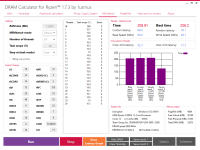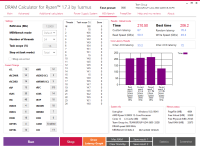I just go with 8 packs advice.
8 Pack said:
↑
For 24-7 1.5v is fine on Samsung IC. Heat spreaders are also only for looks no cooling is needed.
As with most things said about memory by anyone, anywhere, ever... that's mostly true

. Its very rare you can make a blanket statement concerning memory, XMP was created to make stable custom timings possible so if you are using XMP then the statement is 100% correct. If tuning timings however you will end up running slacker timings if you don't control memory temperatures OR you need to leave trrd's and tfaw slack to throttle throughput (if you stability test anyway, may not be required for gaming/light loading depending on case temp etc etc). There is a direct correlation between die temperature and overclocking capability when talking about B-die, it's incredibly temperature sensitive. I believe if you reported any type of heat issues or instability then the first step in a support call would be to test at XMP, therefore applying a hard TRRD throttle and bringing temps down.
B-die does not reach high temperatures compared to something like a cpu, it will rarely if ever exceed 55c no matter what you do...but its overclocking performance and latency potential is still very sensitive to operating temperatures even though its operating temperature range is much lower.
Its important to understand what was being stated by 8 Pack there - the statement says 1.5v will not harm your B-Die dimms or make them overheat. It does not state you will get the same overclocked performance if you don't cool your memory when running 1.5v. Cooling B-Die is required if you want to achieve optimum performance from as low as the 1.4v to 1.45v range depending on your case temperatures and memory loading. If you are happy leaving a TRRD/TFAW throttle in place, no cooling is required ever. That doesn't quite roll off the tongue like "1.5v is fine without cooling on B-Die" though...

Mate I ran Super PI today to compare the 2 configurations. Pretty similar results
3828c14 --- 8m 27 . 388s
4097c15 --- 8m 27 . 773s
Finally found time to do some testing myself today, I was really curious what I could achieve. Sadly it turns out the Gigabyte X570i is trash compared the MSI B450i at high memory mhz. I couldnt boot at XMP 4400mhz or even over 4333mhz no matter what I tried on the Gigabyte X570i, timings, voltages, nothing mattered. On the MSI B450i XMP works without issue and allows an overclock without touching anything except memory multiplier up to 4666mhz. At 4666mhz its then capable of booting into windows at 16-16-16-16-35-GDM for a cpuz validation - I did this in September (maybe?) last year but didn't adjust any secondary or tertiary timings or run benches, I was just going for max bootable in to windows to satisfy curiosity. I did post a link to the validation either on here or xtremesystems but I've since lost the link.
Initially 4333mhz @ 16-15-15 1T looked really promising - 85.95 seconds to complete memtest easy bench and 164.09 seconds to complete default. However when I ran MaxxMem the story became clear - performance in every metric it measured was lower than my 1:1 3733mhz settings. Latency was the killer falling back from 61.2ns to 67.3ns, as maxxmem measures its bandwidth by performing pi calcs the latency and inbalance in the Infinity Fabric and cache speeds really showed. Linpack confirmed it was a drop of around 1.5% in GFLOPS. I didn't screen cap it, I went to try reducing TRP, TRAS and TRFC expecting a bit of improvement and destroyed ntoskrnl.exe on the next reboot. Game over man - didn't even get to try GDM enabled before Windows got eaten.
Interestingly the only subtiming requiring change to boot all the way from 3733mhz up to 4333mhz was tWCL (set to match CL-2). Other than that you only need to touch slacken Primaries (+ match TRC/TRFC) to get 4333mhz, even the Tertiaries with SCLs at 2 and everything else at 1 worked fine. Proves how strong the memory controller is, shame the architecture isn't letting it spread its wings. TRCD 15 at 4333mhz is nuts.



 . Its very rare you can make a blanket statement concerning memory, XMP was created to make stable custom timings possible so if you are using XMP then the statement is 100% correct. If tuning timings however you will end up running slacker timings if you don't control memory temperatures OR you need to leave trrd's and tfaw slack to throttle throughput (if you stability test anyway, may not be required for gaming/light loading depending on case temp etc etc). There is a direct correlation between die temperature and overclocking capability when talking about B-die, it's incredibly temperature sensitive. I believe if you reported any type of heat issues or instability then the first step in a support call would be to test at XMP, therefore applying a hard TRRD throttle and bringing temps down.
. Its very rare you can make a blanket statement concerning memory, XMP was created to make stable custom timings possible so if you are using XMP then the statement is 100% correct. If tuning timings however you will end up running slacker timings if you don't control memory temperatures OR you need to leave trrd's and tfaw slack to throttle throughput (if you stability test anyway, may not be required for gaming/light loading depending on case temp etc etc). There is a direct correlation between die temperature and overclocking capability when talking about B-die, it's incredibly temperature sensitive. I believe if you reported any type of heat issues or instability then the first step in a support call would be to test at XMP, therefore applying a hard TRRD throttle and bringing temps down.


